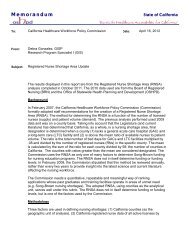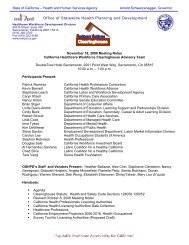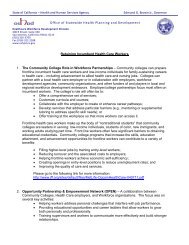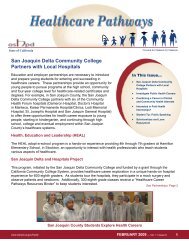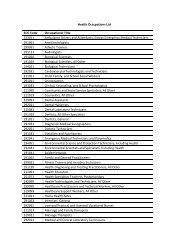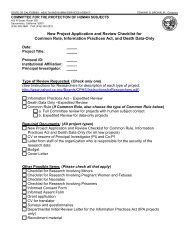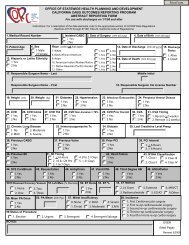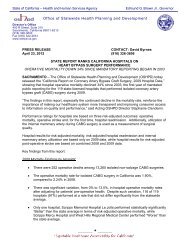Best Practices for Project Management, Design, and Construction of ...
Best Practices for Project Management, Design, and Construction of ...
Best Practices for Project Management, Design, and Construction of ...
Create successful ePaper yourself
Turn your PDF publications into a flip-book with our unique Google optimized e-Paper software.
OSHPD maintains several different approaches to review <strong>and</strong> permitting, many <strong>of</strong> which may be<br />
selected by the project proponent. <strong>Project</strong> applications that do not specify a particular approach<br />
will be reviewed as a st<strong>and</strong>ard project: permits <strong>for</strong> new construction <strong>and</strong> remodel projects that<br />
alter the existing structural frame (<strong>for</strong>merly known as “H” projects) <strong>and</strong> permits <strong>for</strong> new<br />
construction that do not alter the existing structural frame (<strong>for</strong>merly known as “S” projects).<br />
OSHPD maintains st<strong>and</strong>ard turnaround targets <strong>for</strong> these types <strong>of</strong> projects. OSHPD <strong>of</strong>fers a<br />
“preliminary” review process these projects to look at major code issues prior to completion <strong>of</strong><br />
construction documents. OSHPD also <strong>of</strong>fers a program where limits <strong>of</strong> work can be agreed upon<br />
prior to permitting.<br />
Additional automatic <strong>and</strong> optional plan review programs include:<br />
• Annual permit – covers up to $50,000 in very small work on an annual basis.<br />
• AB 2632 project – supports certain types <strong>of</strong> maintenance <strong>and</strong> repair work <strong>for</strong> single story<br />
buildings.<br />
• SB 1838 <strong>Project</strong> – under $50,000. An owner can select the SB 1838 application <strong>for</strong> work<br />
under $50,000 excluding the cost <strong>of</strong> fixed equipment. <strong>Project</strong>s using SB 1838 are not plan<br />
reviewed; they are triaged to ensure eligibility <strong>for</strong> the program followed by issuance <strong>of</strong> a<br />
permit. The SB 1838 permit is intended to expedite commencement <strong>of</strong> construction <strong>for</strong><br />
very small projects; the risk to use <strong>of</strong> this method comes from the potential to construct<br />
something to a non-code con<strong>for</strong>ming condition which may require correction in later work.<br />
• Rapid Review Unit – under $100,000. OSHPD will automatically route all projects under<br />
$100,000 in value excluding the cost <strong>of</strong> fixed equipment to this unit <strong>for</strong> full review prior to<br />
permitting. Turnaround <strong>for</strong> the RRU is longer than that <strong>for</strong> an SB 1838 but substantially<br />
shorter than that <strong>for</strong> a regular “H” or “S” project. Full review also eliminates the risk <strong>of</strong> work<br />
not being in con<strong>for</strong>mance with code that arises from use <strong>of</strong> the SB 1838 permit.<br />
• Incremental <strong>Project</strong>s – new construction <strong>and</strong> remodel projects that alter the existing<br />
structural frame (<strong>for</strong>merly known as “H” projects) may be separated into two or more<br />
permit sets by applying <strong>for</strong> it to be an Incremental (<strong>for</strong>merly known as “I”) project instead.<br />
Each increment <strong>of</strong> these types <strong>of</strong> projects must represent one or more complete building<br />
system. The incremental project method is typically chosen <strong>for</strong> large projects to allow <strong>for</strong><br />
some portion <strong>of</strong> work to commence while other portions continue through the plan review<br />
process. The project proponent must request use <strong>of</strong> the incremental project; OSHPD will<br />
determine whether the proposal meets the requirement <strong>of</strong> code <strong>and</strong> is separated into<br />
appropriate increment packages.<br />
• Phased Plan Review (PPR) – established by SB 306, PPR is a voluntary review process<br />
that must be proposed by the project proponent <strong>and</strong> approved by OSHPD prior to<br />
engagement. OSHPD is not obligated to accept any project <strong>for</strong> phased plan review. PPR<br />
functions as a method to resolve all code issues prior to development <strong>of</strong> construction<br />
documents, assuring their highest possible quality. PPR works well with new construction<br />
<strong>and</strong> remodel projects that alter the existing structural frame, or those that do not alter the<br />
existing structural frame (<strong>for</strong>merly known as “H” or “I” projects); project teams using<br />
Integrated <strong>Project</strong> Delivery (IPD) methods will see PPR as a way <strong>of</strong> ensuring con<strong>for</strong>ming<br />
design at the earliest possible opportunity during design phase to eliminate waste.<br />
(OSHPD <strong>Best</strong> <strong>Practices</strong>) Page 94 DRAFT FINAL, Sept. 2011



